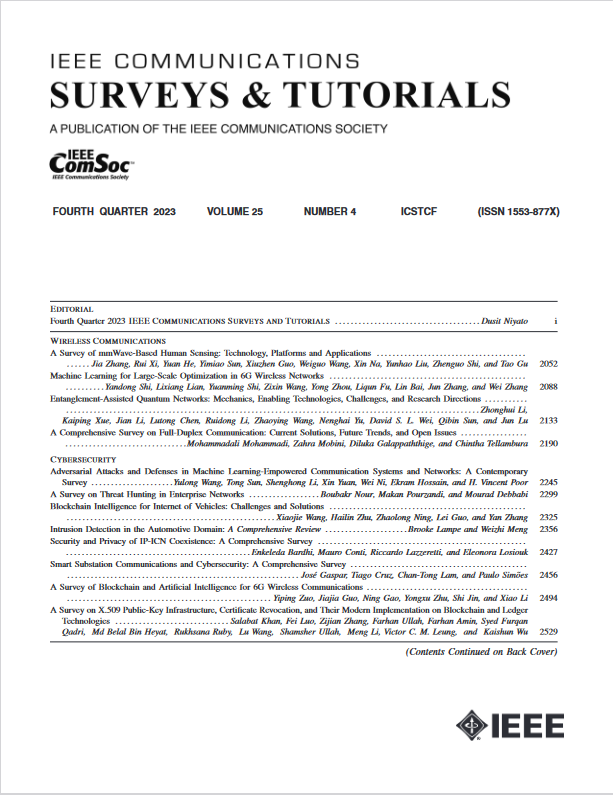毫米波 V2X 通信中的波束对准:调查
IF 34.4
1区 计算机科学
Q1 COMPUTER SCIENCE, INFORMATION SYSTEMS
引用次数: 0
摘要
汽车行业的数字化转型正在加速迈向以自动驾驶汽车为主导的时代,而车对一切(V2X)通信则是实现这一进步的基本手段。随着车辆网络不断发展以满足自动驾驶的复杂需求,传统通信系统在带宽和数据传输速率方面遇到了限制。毫米波(mmWave)通信是一种关键的解决方案,它提供了现代车载通信所需的高数据吞吐量和低延迟所需的宽带。然而,挑战也迫在眉睫,毫米波 V2X 的波束对准成为一个耗时的过程,毫米波的阻塞效应阻碍了稳定可靠的车载通信链路。因此,开发高效、实时和稳健的波束对准技术对毫米波 V2X 通信至关重要。本文全面介绍了毫米波 V2X 通信中的波束对准技术。我们探讨了各种方法,包括波束扫描、到达角(AoA)/方向角(AoD)估计、黑盒优化和侧信息。随后,我们介绍了评估波束对准性能的性能指标,并比较了四种波束对准方法在不同指标下的性能。最后,我们总结了毫米波 V2X 通信中波束对准技术的未来研究方向和面临的挑战,为该领域的研究人员提供了宝贵的见解。本文章由计算机程序翻译,如有差异,请以英文原文为准。
Beam Alignment in mmWave V2X Communications: A Survey
The digital transformation within the automotive industry is accelerating towards an era dominated by autonomous vehicles, with vehicle-to-everything (V2X) communications being a fundamental enabler for this advancement. As vehicular networks evolve to meet the complex demands of autonomous driving, traditional communication systems encounter limitations in bandwidth and data transfer rates. Millimeter-wave (mmWave) communication emerges as a pivotal solution, offering the extensive bandwidth required for the high data throughput and low latency essential in modern vehicular communications. However, challenges loom, with beam alignment in mmWave V2X becoming a time-consuming process and the mmWave’s blockage effect impeding consistent and reliable vehicular communication links. Therefore, the development of efficient, real-time, and robust beam alignment technology is crucial for mmWave V2X communication. In this paper, we present a comprehensive survey of beam alignment techniques in mmWave V2X communication. We explore various approaches including beam sweeping, angle of arrival (AoA)/angle of direction (AoD) estimation, black-box optimization, and side information. Subsequently, we introduce performance metrics for assessing beam alignment performance and compare the performance of four beam alignment methods under different metrics. Finally, we summarize the future research directions and challenges faced by beam alignment techniques in mmWave V2X communication, offering valuable insights for researchers in this field.
求助全文
通过发布文献求助,成功后即可免费获取论文全文。
去求助
来源期刊

IEEE Communications Surveys and Tutorials
COMPUTER SCIENCE, INFORMATION SYSTEMS-TELECOMMUNICATIONS
CiteScore
80.20
自引率
2.50%
发文量
84
审稿时长
6 months
期刊介绍:
IEEE Communications Surveys & Tutorials is an online journal published by the IEEE Communications Society for tutorials and surveys covering all aspects of the communications field. Telecommunications technology is progressing at a rapid pace, and the IEEE Communications Society is committed to providing researchers and other professionals the information and tools to stay abreast. IEEE Communications Surveys and Tutorials focuses on integrating and adding understanding to the existing literature on communications, putting results in context. Whether searching for in-depth information about a familiar area or an introduction into a new area, IEEE Communications Surveys & Tutorials aims to be the premier source of peer-reviewed, comprehensive tutorials and surveys, and pointers to further sources. IEEE Communications Surveys & Tutorials publishes only articles exclusively written for IEEE Communications Surveys & Tutorials and go through a rigorous review process before their publication in the quarterly issues.
A tutorial article in the IEEE Communications Surveys & Tutorials should be designed to help the reader to become familiar with and learn something specific about a chosen topic. In contrast, the term survey, as applied here, is defined to mean a survey of the literature. A survey article in IEEE Communications Surveys & Tutorials should provide a comprehensive review of developments in a selected area, covering its development from its inception to its current state and beyond, and illustrating its development through liberal citations from the literature. Both tutorials and surveys should be tutorial in nature and should be written in a style comprehensible to readers outside the specialty of the article.
 求助内容:
求助内容: 应助结果提醒方式:
应助结果提醒方式:


